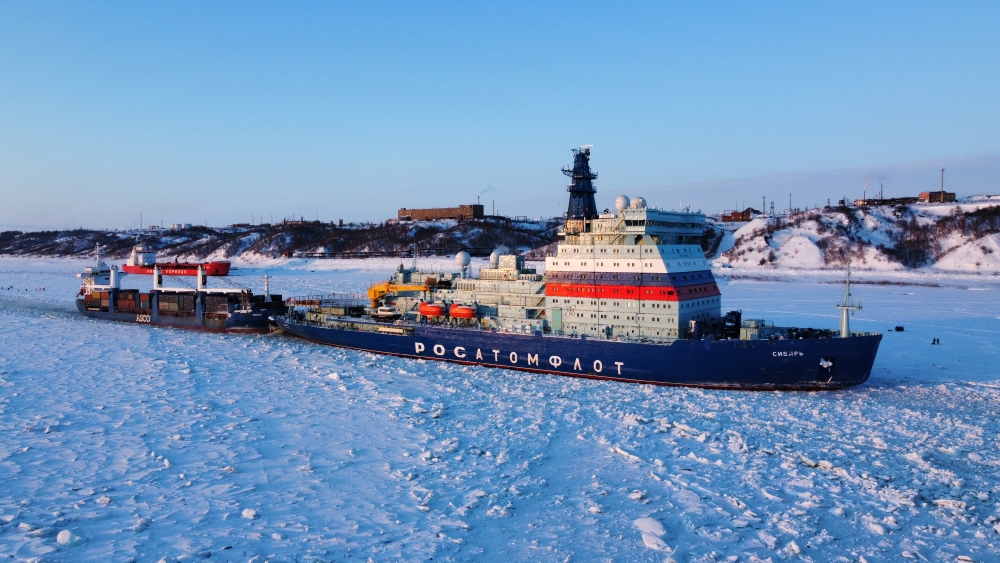
The ships are to be put into operation in December 2028 and in December 2030 respectively
FSUE Atomflot (a company of Rosatom) and Baltiysky Zavod JSC (a company of United Shipbuilding Corporation, USC) have signed a contract for construction of the fifth and sixth nuclear-powered icebreakers of Project 22220. The construction will be financed by the federal budget and by Atomflot in a ratio of 50 to 50. The contract foresees the commissioning of the fifth serial icebreaker in December 2028, the sixth – in December 2030, says FSUE Atomflot.
“The extension of the series of universal nuclear-powered icebreakers is the key element in the comprehensive development of the Arctic zone of the Russian Federation,” said Leonid Irlitsa, Acting Director General of FSUE Atomflot. — Despite external factors, we are implementing a plan to build up cargo shipping in the Northern Sea Route waters. Modern nuclear-powered icebreakers are the foundation for the success of Arctic projects. Only we can ensure safe escorting of ships at a commercial speed in high latitudes.”
Three nuclear-powered icebreakers of Project 22220, Arktika Sibir and Ural, have already been put into operation on the Northern Sea Route. The Yakutia and the Chukotka are under construction with the delivery scheduled for December 2024 and December 2026 respectively.
Nuclear-powered icebreakers of Project 22220 will contribute to opening year-round navigation in the Eastern sector of the Northern Sea Route.
Key particulars of Project 22220: LOA - 168.2 m; beam - 34 m (33 m, DWL); draft (DWL) - 10.5 m; minimum draft – 9.3 m, full displacement – 33,540 tonnes; maximum icebreaking capability - 2.8-meter-thick ice (at full capacity and speed of 1.5-2 knots); designated service life - 40 years, crew - 54.
State Atomic Energy Corporation ROSATOM has been a single infrastructure operator of the Northern Sea Route from 2018. It is in charge of organizing shipping, construction of infrastructure facilities, ensuring navigation and hydrographic support and safety in challenging Arctic conditions. The authority of Rosatom’s NSR Directorate covers Atomflot, Hydrographic Company and Glavsevmorput.
To increase the cargo traffic on the Northern Sea Route Rosatom is building up its fleet of icebreakers which is to number 17 units by 2030 and 22, according to earlier statements by Rosatom. Apart from the icebreakers being built by Baltiysky Zavod, a nuclear-powered icebreaker of Leader type is under construction at Shipbuilding Complex “Zvezda” (Bolshoy Kamen, Primorsky Territory).
The Northern Sea Route is a single transport system in the Russian Arctic sector. It stretches along the northern coasts of Russia across the seas of the Arctic Ocean (Kara, Laptev, East Siberian, Chukchi seas). The route links the European ports of Russia with the mouths of navigable rivers in Siberia and the Far East. In August 2022, a plan for the development of the Northern Sea Route (NSR) until 2035 was approved. The plan includes over 150 activities with total financing nearing RUB 1.8 trillion.
According to the plan, the annual cargo traffic on the Northern Sea Route is to reach 80 million by 2024, 150 million tonnes by 2030, 220 million tonnes – by 2035.
Saint-Petersburg, Russia based Baltiysky Zavod shipyard (Baltic Shipyard) was established in 1856 and today is a 100% subsidiary of the state-owned United Shipbuilding Corporation (USC). The shipyard specializes in the construction of Rank 1 surface crafts, ice class vessels with nuclear and diesel-electric propulsion, of nuclear floating energy units and floating distilling plants. Baltic Shipyard has built over 600 ships and vessels. The shipyard employs more than 6,000 people.



